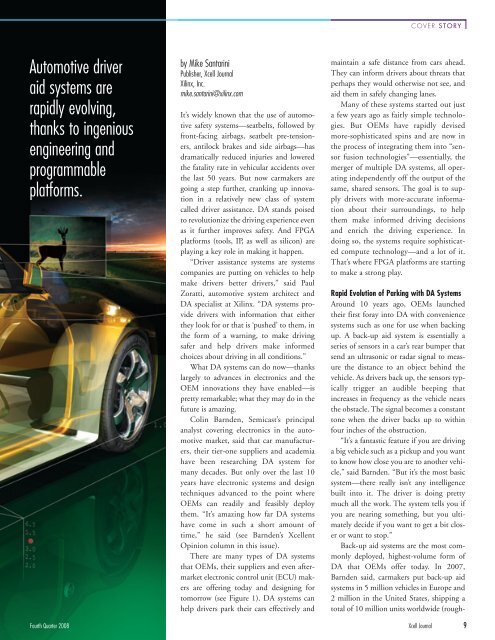Automotive Innovators Hit High Gear in - Xilinx
Automotive Innovators Hit High Gear in - Xilinx
Automotive Innovators Hit High Gear in - Xilinx
Create successful ePaper yourself
Turn your PDF publications into a flip-book with our unique Google optimized e-Paper software.
<strong>Automotive</strong> driver<br />
aid systems are<br />
rapidly evolv<strong>in</strong>g,<br />
thanks to <strong>in</strong>genious<br />
eng<strong>in</strong>eer<strong>in</strong>g and<br />
programmable<br />
platforms.<br />
by Mike Santar<strong>in</strong>i<br />
Publisher, Xcell Journal<br />
Xil<strong>in</strong>x, Inc.<br />
mike.santar<strong>in</strong>i@xil<strong>in</strong>x.com<br />
It’s widely known that the use of automotive<br />
safety systems—seatbelts, followed by<br />
front-fac<strong>in</strong>g airbags, seatbelt pre-tensioners,<br />
antilock brakes and side airbags—has<br />
dramatically reduced <strong>in</strong>juries and lowered<br />
the fatality rate <strong>in</strong> vehicular accidents over<br />
the last 50 years. But now carmakers are<br />
go<strong>in</strong>g a step further, crank<strong>in</strong>g up <strong>in</strong>novation<br />
<strong>in</strong> a relatively new class of system<br />
called driver assistance. DA stands poised<br />
to revolutionize the driv<strong>in</strong>g experience even<br />
as it further improves safety. And FPGA<br />
platforms (tools, IP, as well as silicon) are<br />
play<strong>in</strong>g a key role <strong>in</strong> mak<strong>in</strong>g it happen.<br />
“Driver assistance systems are systems<br />
companies are putt<strong>in</strong>g on vehicles to help<br />
make drivers better drivers,” said Paul<br />
Zoratti, automotive system architect and<br />
DA specialist at Xil<strong>in</strong>x. “DA systems provide<br />
drivers with <strong>in</strong>formation that either<br />
they look for or that is ‘pushed’ to them, <strong>in</strong><br />
the form of a warn<strong>in</strong>g, to make driv<strong>in</strong>g<br />
safer and help drivers make <strong>in</strong>formed<br />
choices about driv<strong>in</strong>g <strong>in</strong> all conditions.”<br />
What DA systems can do now—thanks<br />
largely to advances <strong>in</strong> electronics and the<br />
OEM <strong>in</strong>novations they have enabled—is<br />
pretty remarkable; what they may do <strong>in</strong> the<br />
future is amaz<strong>in</strong>g.<br />
Col<strong>in</strong> Barnden, Semicast’s pr<strong>in</strong>cipal<br />
analyst cover<strong>in</strong>g electronics <strong>in</strong> the automotive<br />
market, said that car manufacturers,<br />
their tier-one suppliers and academia<br />
have been research<strong>in</strong>g DA system for<br />
many decades. But only over the last 10<br />
years have electronic systems and design<br />
techniques advanced to the po<strong>in</strong>t where<br />
OEMs can readily and feasibly deploy<br />
them. “It’s amaz<strong>in</strong>g how far DA systems<br />
have come <strong>in</strong> such a short amount of<br />
time,” he said (see Barnden’s Xcellent<br />
Op<strong>in</strong>ion column <strong>in</strong> this issue).<br />
There are many types of DA systems<br />
that OEMs, their suppliers and even aftermarket<br />
electronic control unit (ECU) makers<br />
are offer<strong>in</strong>g today and design<strong>in</strong>g for<br />
tomorrow (see Figure 1). DA systems can<br />
help drivers park their cars effectively and<br />
COVER STORY<br />
ma<strong>in</strong>ta<strong>in</strong> a safe distance from cars ahead.<br />
They can <strong>in</strong>form drivers about threats that<br />
perhaps they would otherwise not see, and<br />
aid them <strong>in</strong> safely chang<strong>in</strong>g lanes.<br />
Many of these systems started out just<br />
a few years ago as fairly simple technologies.<br />
But OEMs have rapidly devised<br />
more-sophisticated sp<strong>in</strong>s and are now <strong>in</strong><br />
the process of <strong>in</strong>tegrat<strong>in</strong>g them <strong>in</strong>to “sensor<br />
fusion technologies”—essentially, the<br />
merger of multiple DA systems, all operat<strong>in</strong>g<br />
<strong>in</strong>dependently off the output of the<br />
same, shared sensors. The goal is to supply<br />
drivers with more-accurate <strong>in</strong>formation<br />
about their surround<strong>in</strong>gs, to help<br />
them make <strong>in</strong>formed driv<strong>in</strong>g decisions<br />
and enrich the driv<strong>in</strong>g experience. In<br />
do<strong>in</strong>g so, the systems require sophisticated<br />
compute technology—and a lot of it.<br />
That’s where FPGA platforms are start<strong>in</strong>g<br />
to make a strong play.<br />
Rapid Evolution of Park<strong>in</strong>g with DA Systems<br />
Around 10 years ago, OEMs launched<br />
their first foray <strong>in</strong>to DA with convenience<br />
systems such as one for use when back<strong>in</strong>g<br />
up. A back-up aid system is essentially a<br />
series of sensors <strong>in</strong> a car’s rear bumper that<br />
send an ultrasonic or radar signal to measure<br />
the distance to an object beh<strong>in</strong>d the<br />
vehicle. As drivers back up, the sensors typically<br />
trigger an audible beep<strong>in</strong>g that<br />
<strong>in</strong>creases <strong>in</strong> frequency as the vehicle nears<br />
the obstacle. The signal becomes a constant<br />
tone when the driver backs up to with<strong>in</strong><br />
four <strong>in</strong>ches of the obstruction.<br />
“It’s a fantastic feature if you are driv<strong>in</strong>g<br />
a big vehicle such as a pickup and you want<br />
to know how close you are to another vehicle,”<br />
said Barnden. “But it’s the most basic<br />
system—there really isn’t any <strong>in</strong>telligence<br />
built <strong>in</strong>to it. The driver is do<strong>in</strong>g pretty<br />
much all the work. The system tells you if<br />
you are near<strong>in</strong>g someth<strong>in</strong>g, but you ultimately<br />
decide if you want to get a bit closer<br />
or want to stop.”<br />
Back-up aid systems are the most commonly<br />
deployed, highest-volume form of<br />
DA that OEMs offer today. In 2007,<br />
Barnden said, carmakers put back-up aid<br />
systems <strong>in</strong> 5 million vehicles <strong>in</strong> Europe and<br />
2 million <strong>in</strong> the United States, shipp<strong>in</strong>g a<br />
total of 10 million units worldwide (rough-<br />
Fourth Quarter 2008 Xcell Journal 9

















